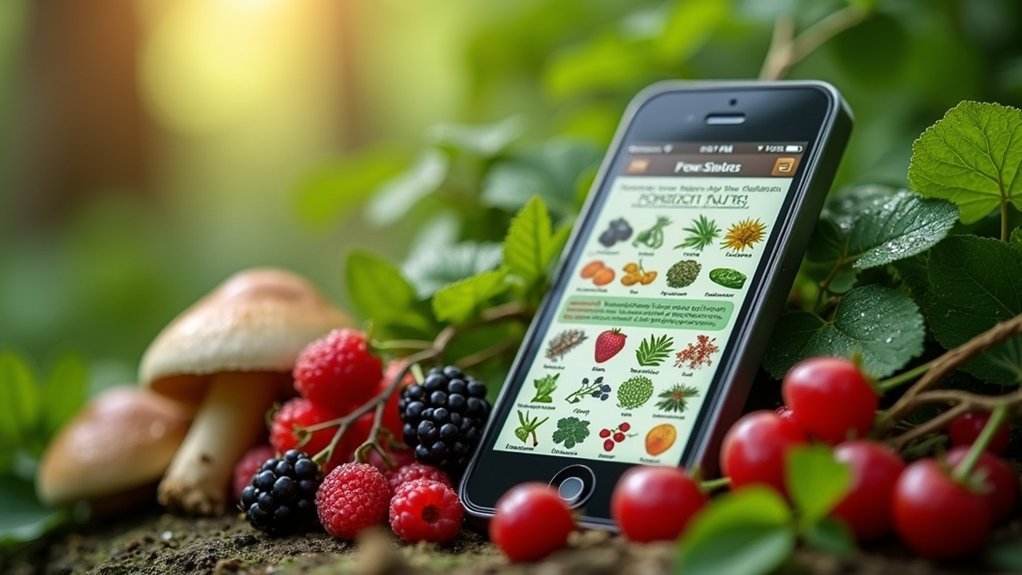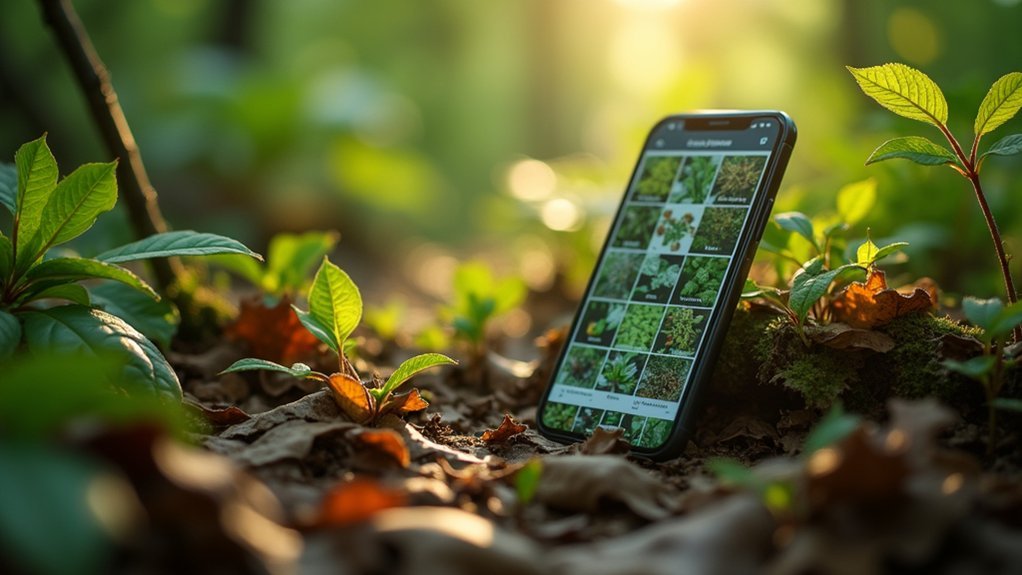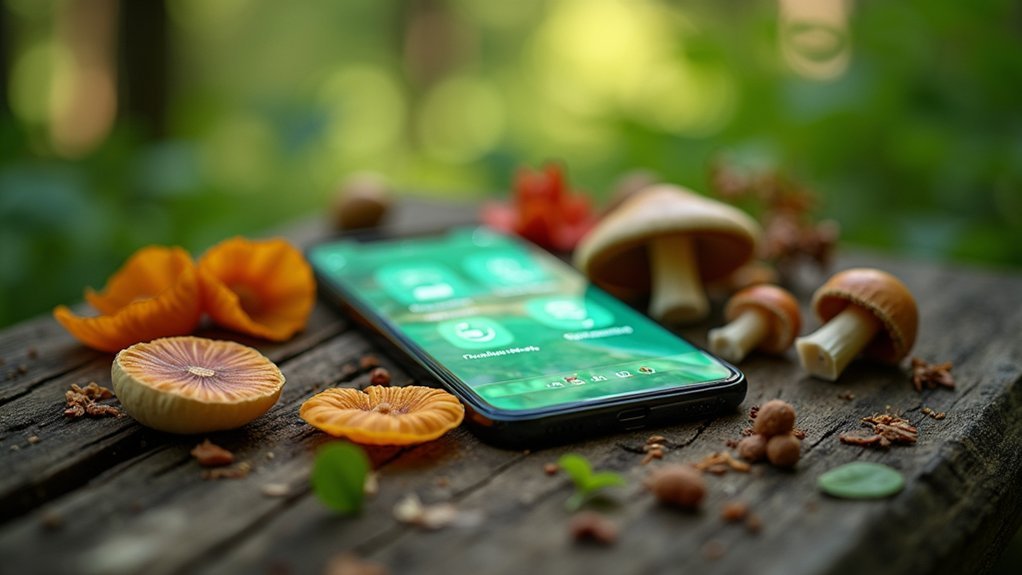To master your foraging app, first optimize your profile with location settings. Learn to take clear, multi-angle plant photos for accurate AI identification. Enable all safety alerts for poisonous lookalikes. Create custom routes with GPS tracking and mark private spots. Build a seasonal foraging calendar. Connect with local communities for regional insights. Use advanced search filters for urban environments. Document your finds and contribute to the knowledge base. The journey from novice to expert forager awaits below.
10 Steps to Master Your Foraging App

While mastering a foraging app might seem intimidating at first, the journey begins with understanding its core features.
Start by exploring the interactive maps in apps like Forager's Buddy to mark your favorite spots and create custom trails using GPS tracking.
Mark your spots, track your trails, and navigate nature's bounty with interactive mapping features.
Next, familiarize yourself with plant identification tools such as PlantSnap, which uses AI to identify plants from your photos.
Learn to navigate the plant databases, noting seasonal availability information to enhance your foraging expeditions.
Don't overlook safety features—check for emergency calls and SMS options, toxicity warnings, and weather integration.
Finally, engage with the community aspects by contributing to databases, sharing your finds, and joining discussions with fellow foragers.
Set custom reminders for ideal harvesting times and explore the nutritional information about your discoveries.
Consider customizing your experience with personalization options that filter plants based on your dietary needs and preferences.
Setting Up Your Profile and Location Preferences
Your foraging app becomes truly useful when you've tailored the feed to display only plants relevant to your interests and local ecosystem.
You'll want to set your preferred foraging radius—whether it's within walking distance of your home or includes broader regional territories you frequently visit.
This personalization guarantees you receive timely notifications about seasonal availability and rare findings specifically within areas you're most likely to explore. Remember that while apps like iNaturalist can provide suggestions, they should be used as identification aids only and never as the sole method for determining if a plant is safe to consume.
Personalizing Your Feed
How effectively you personalize your foraging app determines its usefulness in your wild food adventures.
Start by customizing your notification preferences for seasonal plant alerts and updates on your favorite species. You'll never miss peak harvesting times when you set alerts based on what grows in your region.
Tailor your feed to showcase plants you're interested in learning about or finding. With the Wild Edibles app featuring over 250 plants and more than 1,000 images, you can easily narrow down which species to focus on. Most apps allow you to filter content by plant type, season, or difficulty level.
Save favorite foraging trails and organize them by location or harvest season for quick access.
Don't overlook the social features – follow experienced foragers whose knowledge aligns with your interests. Their shared discoveries and tips can enhance your feed with valuable insights while connecting you to a community of like-minded enthusiasts.
Customize Foraging Radius
Setting the right foraging radius on your app creates a personalized exploration zone that matches your foraging habits and mobility.
Research shows that intermediate radii (0.01-0.1) typically balance global and local efficiency best, giving you ideal resource discovery without excessive travel.
You'll want to adjust your radius based on habitat quality and resource distribution in your area. Smaller radii work well in resource-dense environments, increasing your interaction rate with nearby finds.
Larger settings are better for patchy landscapes where resources are scattered, though they'll result in fewer but longer foraging trips.
Use the app's customizable settings to apply different radii for specific item types or locations. Using a central-place foraging strategy helps organize your exploration patterns while maintaining connections with other foragers in the area. This strategic approach helps you maximize your foraging efficiency while maintaining a fixed home base for your adventures.
Mastering Plant Identification Features

You'll improve your foraging app success by holding your camera steady and capturing plants from multiple angles, which greatly enhances visual recognition accuracy.
Most quality apps now include critical poisonous lookalike alerts that flag potentially dangerous plants resembling edible species—never bypass these warnings. For maximum safety, use apps like Picture This or Seek as initial screening tools, but always cross-reference multiple sources when identifying plants for consumption.
Changing seasons affect plant appearances dramatically, so you'll need to adjust your identification approach as flowers shift to fruits, leaves change color, or plants enter dormancy.
Visual Recognition Tips
When you're out in the field, the success of your foraging expedition often hinges on your app's ability to accurately identify plants from photos. Maximize your results by capturing clear, well-lit images in natural daylight, focusing on multiple plant parts including leaves, flowers, and stems.
Position your camera steadily and fill the frame with the subject while ensuring a neutral background. For best results, take multiple shots from different angles.
Remember that apps like PictureThis and PlantSnap perform better with high-quality images and benefit from their extensive databases. Be aware that apps typically have a 5-10% chance of providing confidently incorrect identifications that could be dangerous for foragers.
In areas with spotty reception, use apps with offline capabilities like PlantSnap. Always cross-validate identifications using multiple sources—especially for plants you intend to consume—as no app provides 100% accuracy when your safety is concerned.
Poisonous Lookalike Alerts
The danger of misidentification lurks behind every foraging expedition, making poisonous lookalike alerts one of the most critical features in any foraging app. Plants like Death Camas and Poison Hemlock can closely resemble edible species, with potentially fatal consequences if consumed. Most foraging apps can't account for environmental factors affecting plant characteristics and safety.
| Poisonous Plant | Edible Lookalike |
|---|---|
| Death Camas | Wild Onion |
| Poison Hemlock | Wild Carrot |
| Water Hemlock | Queen Anne's Lace |
| False Morel | True Morel |
| Lily of the Valley | Wild Garlic |
Don't rely solely on your app for identification. Even the best apps have accuracy rates as low as 5.8% for some poisonous species. Always cross-verify with field guides, expert consultation, or community feedback. Use your app's lookalike alerts as a first warning system, but supplement with multiple verification sources before consuming any foraged plant.
Seasonal Identification Challenges
Why do plants play hide-and-seek with foragers throughout the year? It's because they transform dramatically with the seasons. Your foraging app needs to account for these changes to remain useful year-round.
In spring, you'll need help identifying rapidly growing greens like dandelion and chickweed.
Summer brings the challenge of distinguishing edible flowers among dense vegetation.
Fall shifts your focus to mature fruits, nuts, and color-changing leaves.
Winter requires recognizing plants by their evergreen features, distinctive bark, or persistent seeds.
Weather variations further complicate identification. During drought, plants may appear stunted; after frost, they'll show damage. High-quality apps can often help identify toxic look-alikes that may be easily confused with edible species.
Configure your app's seasonal filters and weather condition settings to overcome these challenges and maintain accurate identification regardless of when you're foraging.
Understanding Safety Guidelines and Alerts

Maneuvering the world of wild edibles requires a solid understanding of safety protocols, as even the most sophisticated foraging apps have limitations. Never rely solely on app identifications, as they lack the sensory inputs experts use and can misidentify dangerous lookalikes. France has reported over 1,200 cases of mushroom poisoning due to app reliance alone.
| Safety Feature | Your Action |
|---|---|
| Alert Notifications | Enable all poisonous plant warnings |
| Lookalike Warnings | Cross-check with field guides before harvesting |
| Contamination Alerts | Avoid foraging in flagged areas |
Always verify plant identities through multiple sources, especially for your first harvests. Start with easily identifiable species like dandelions or blackberries rather than challenging varieties. If you're uncertain about a plant's identity, don't eat it—even experienced foragers follow this cardinal rule. Remember to check local regulations before harvesting in public areas.
Creating Custom Foraging Routes and Maps
You'll get more from your foraging app by creating custom routes that match your specific hunting needs and preferred environments.
Most apps let you plot personalized paths with waypoints for your favorite mushroom patches, berry bushes, or edible plant locations.
You can even mark your secret spots as private while sharing other routes with fellow foragers through exportable maps.
Using the Smart Routing feature enables the app to automatically suggest paths based on your selected activity type, making it easier to find walkable trails for foraging expeditions.
Plot Personalized Paths
When digital mapping meets foraging expertise, your outdoor adventures transform from random wanderings into strategic harvests.
Custom trails allow you to maximize each outing by focusing on specific plants you're seeking. Start by using the GPS-based trail marking to create your own routes or explore pre-loaded maps from experienced foragers.
Record your successful paths for future reference, and customize your map display to highlight seasonal availability. Apps like Forager Diary are perfect for tracking specific foraging spots in complex environments with multiple parks and trails.
Don't overlook the power of community input—user-suggested trails often reveal hidden treasures. For maximum efficiency, export your routes in .kml or .gpx formats to use offline or with other navigation tools.
As you discover productive locations, contribute to the ecosystem by sharing your trails and adding reviews. Your feedback refines the app's algorithms, making recommendations more accurate for everyone.
Share Secret Spots
Digital cartography has revolutionized how foragers document and share their discoveries. With tools like Google My Maps and AllTrails, you're now equipped to create custom foraging routes and share them with trusted companions.
Control who sees your prized locations by adjusting privacy settings and sharing specific layers rather than entire maps.
- Create distinct layers for different foraging types (mushrooms, berries, herbs)
- Share via URL with selective permissions for viewing or editing
- Embed your maps into foraging blogs or community websites
- Use collaborative editing to build extensive regional foraging resources
When sharing sensitive locations, consider using broad areas rather than precise coordinates for sustainability. Start by opening Google Maps in your browser and signing into your account to access the Create Map function for developing detailed foraging routes.
Remember that browser-based tools offer more flexibility than apps when creating detailed custom routes on mobile devices.
Tracking Seasonal Availability and Harvesting Times
Understanding the rhythm of nature's calendar transforms your foraging experience from random collection to strategic harvesting. Your foraging app can become an essential tool for tracking when specific plants reach their peak in your region.
Set up notifications for approaching harvest windows of your favorite species, and you'll never miss prime picking conditions. Most apps allow you to log climate patterns alongside harvests, helping you predict future availability with greater accuracy. This approach supports a more diverse intake of seasonal nutrients throughout the year, optimizing your nutritional benefits from foraged foods.
Take advantage of features that compare current conditions with historical data, as many wild edibles appear earlier or later depending on seasonal variations.
Don't forget to note the quality of your finds in different locations throughout the season – this information becomes invaluable as you build your personalized foraging calendar year after year.
Building Your Digital Foraging Journal
Beyond tracking seasons, creating a robust digital journal transforms casual foraging into a methodical pursuit.
You'll need to document essential data that enhances both safety and success on future expeditions. Modern apps let you compile thorough records with GPS coordinates, photos at various growth stages, and detailed notes—all searchable through metadata tags. The Digital Foraging Journal provides printable pages designed specifically for nature enthusiasts to document their findings effectively.
- Include plant identifiers and toxic look-alikes to prevent dangerous mistakes
- Record GPS locations and weather conditions for ideal return visits
- Photograph specimens at different growth stages for reliable identification
- Document recipes and processing methods for your harvested treasures
Don't underestimate the power of mistake documentation. By tracking what went wrong, you'll build expertise faster and avoid repeating errors.
Cloud storage guarantees your valuable data remains secure and accessible wherever your foraging adventures take you.
Connecting With Local Foraging Communities

While your foraging expertise grows through personal experience, connecting with like-minded enthusiasts amplifies your knowledge exponentially. Your foraging app can serve as a gateway to these valuable communities.
Join regional Facebook groups like the North Alabama Foraging Club or specialized Discord servers where experts share identification tips and seasonal insights.
Connect with regional wisdom through specialized communities where passionate mentors share their hard-earned foraging knowledge.
Leverage hashtags on Instagram and Twitter to discover local foragers sharing their finds and techniques. Many apps now integrate with these platforms, allowing you to follow influential foragers who post instructional content and seasonal recipes. These online communities often emphasize the importance of having 100% confidence in identification before consuming any foraged plants.
Don't overlook in-person opportunities—many online communities organize guided walks and workshops focused on ethical harvesting practices.
These face-to-face interactions with experienced mentors provide hands-on learning that digital platforms simply can't replicate.
Utilizing Advanced Search Filters for Urban Environments
Urban environments offer a surprising abundance of forageable species, but finding them requires mastering your app's advanced search features.
Geospatial filters let you narrow searches by zip code or neighborhood, while seasonal filters guarantee you're looking for what's currently available. Species selection tools help you target specific plants like wild greens or berries. Many urban foragers are motivated by different factors, forming a bimodal income distribution with highest usage among both high-income and low-income individuals.
To maximize your urban foraging experience:
- Use accessibility filters to distinguish between public areas and private lands requiring permission
- Check for environmental alerts that flag potential soil contamination
- Apply hardiness zone filters to match plants with your local climate conditions
- Leverage community ratings to find the most productive and reliable spots
Don't forget to use real-time updates—urban foraging conditions can change quickly with development or seasonal shifts.
Contributing to the Collective Knowledge Base
Foraging apps derive their true power from users like you who contribute to their knowledge base. When you upload plant photos and share experiences, you're helping build a thorough resource that benefits the entire community. Your contributions enhance the collective wisdom and improve identification accuracy for everyone.
Take advantage of data-sharing features to document plant locations, characteristics, and uses. This collaborative approach creates a dynamic database that grows more valuable with each submission. By participating actively, you'll help reduce misidentification risks while expanding the platform's coverage of diverse species and habitats. The app's user-friendly interface ensures you can navigate seamlessly through the process of contributing content.
Remember that your unique perspective matters—whether you're identifying plants in urban settings or remote wilderness areas. Through your engagement, you're making foraging knowledge globally accessible and supporting sustainable harvesting practices.
Frequently Asked Questions
How Does the App Handle Foraging on Private Property?
The app distinguishes private vs. public lands, warns you against trespassing, and encourages obtaining explicit permission. You'll receive alerts near property boundaries and can document owner permissions within the application.
Can I Use the App Offline in Remote Areas?
Yes, you'll find many foraging apps work offline. Download maps and databases before your trip, and you'll have full functionality in remote areas without signal. Consider bringing an external battery for extended use.
How Accurate Is the Image Recognition for Similar-Looking Species?
Image recognition for similar-looking species is generally limited. Even the best apps like Plant Net reach only 80-88% accuracy. You'll need to cross-reference your findings and never rely solely on apps for identification.
Are There Age Restrictions for Creating an Account?
Yes, most foraging apps have age restrictions. You'll find apps like Wild Edibles and Foraging with the Wildman rated 4+ in app stores, but creating accounts may require you to be older.
Does the App Offer Emergency Identification for Poisoning Cases?
No, the app doesn't offer emergency identification for poisoning cases. You should immediately call poison control or emergency services if you suspect poisoning. Apps lack adequate expertise for life-threatening situations.
In Summary
By following these ten steps, you'll transform from a casual forager into an app-savvy wild food expert. You're now equipped to identify plants confidently, connect with fellow enthusiasts, and safely explore nature's pantry in your neighborhood. Remember, your app is just a tool—your growing expertise and respect for the environment are what truly make you a master forager. Happy harvesting!





Leave a Reply